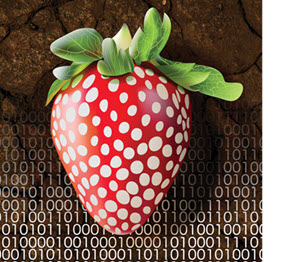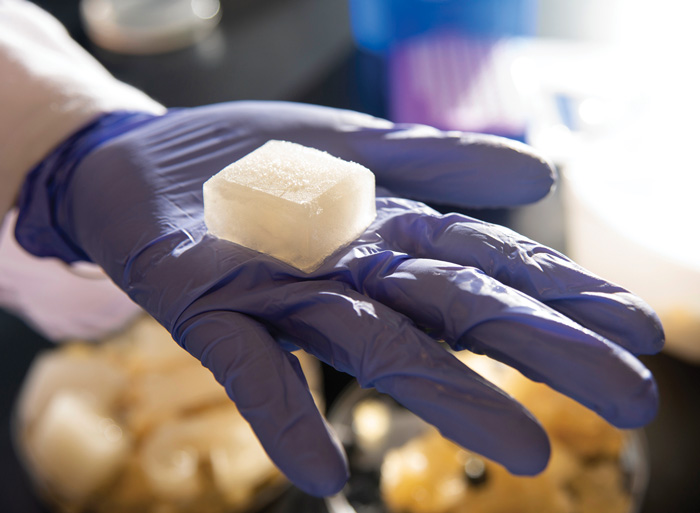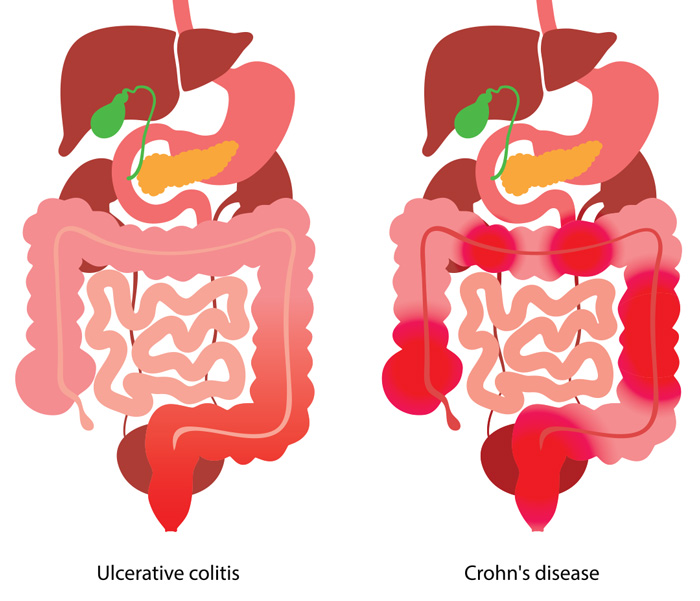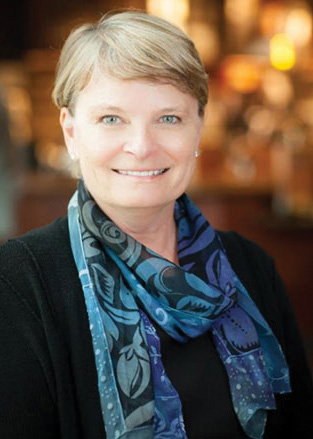A Glimpse Into the Future of Food, Climate-Proofing Crops, and More
OMNIVORE
INDUSTRY
A glimpse into the future of food
TEN FOOD AND agriculture trends are likely to shape the future of food in 2022, according to investment firm S2G Ventures, which foresees a global food transition as a result of changing consumer preferences, climate change, and shifts in the capital market landscape.
“The food transition is still in its infancy but is being propelled by seismic tailwinds,” said Sanjeev Krishnan, S2G Ventures managing director and chief investment officer, in a press release. Among the factors that will affect food and agriculture are advancements in the biology, chemistry, and physics of food production to create new choices, and capital markets, anchored by ESG (Environmental, Social, Governance), in which participants seek to fund high-growth, disruptive companies.
The 10 trends that are shaping the future of food fall into three categories:
- The Fourth Industrial Revolution Comes to the Farm. Farmers in the United States are facing numerous challenges that are both straining their operations and creating the conditions needed for innovation and the adoption of new technologies.
- Supply Chain Disruption Accelerates Innovation. The supply chain disruptions experienced over the past two years have created a sense of urgency to develop solutions that will make supply chains more nimble, sustainable, localized, and less wasteful.
- Consumers Demand Better Food Choices and Experiences. To address declining national health standards as well as consumers’ growing interest in adopting more holistic diets, food and nutrition startups are using cutting-edge science as well as artificial intelligence and machine learning to develop nutrient-dense, functional, and personalized food products
10 Trends Shaping a Healthy Food System
- Robots will bring efficiencies to the food system.
- The rise of ESG will help to digitize the farm.
- Fintech will transform opportunities in agriculture.
- RNA technology will be applied to farms to save soils.
- Fermentation will power next-gen alternative protein products.
- Cellular protein will provide safe, sustainable food.
- Food waste solutions will be viewed as good business and tools to feed the world.
- Artificial intelligence and machine learning will promote understanding of and use cases for plants and fungi.
- Food will become central to disease prevention and improved health outcomes.
- Food brands and grocers will have to “personalize or perish.”
Source: 10 Trends Shaping the Future of Food in 2022 report, S2G Ventures
SAFETY & QUALITY
Jelly cubes keep food cool
A JELLY-LIKE ICE cube developed by researchers at the University of California, Davis, could transform how food is kept cold and shipped fresh, potentially eliminating the need for ice or cooling packs. The plastic-free cubes are gelatin-based hydrogels that are 90% water, do not melt, are compostable and antimicrobial, and prevent cross-contamination.
Luxin Wang, an associate professor in the Department of Food Science and Technology, developed the cubes after seeing how much ice was used at fish processing plants and the potential it created for spreading pathogens.
The cubes, which can be cut to any shape or size, remain frozen for 13 hours and change color depending on temperature. After use, they can be rinsed, refrozen, and used again. Widespread use of the jelly cubes could help reduce water consumption in the food supply chain and control microbial contamination, thus reducing food waste. A patent for the cube design and concept was filed in July 2021.
HEALTH
Microplastics and IBD
THE MICROPLASTICS FOUND in food, bottled water, and the environment are an ongoing source of concern for everyone involved in the food chain. Although it has been estimated that consumers ingest tens of thousands of the particles annually, little is known about the health consequences. But a new study published in Environmental Science & Technology shows that subjects with inflammatory bowel disease (IBD) have more microplastics in their feces than healthy control subjects, suggesting that the fragments could be related to the disease process.
The incidence of IBD, which includes Crohn's disease and ulcerative colitis, is rising, which prompted researchers to explore whether microplastics could contribute to intestinal inflammation or gut microbiome disturbances. As a first step, the scientists decided to compare the levels of microplastics in feces from healthy subjects and people with varying severities of IBD.
Analysis of fecal samples from 50 healthy people and 52 people with IBD from different geographic regions of China showed that feces from IBD patients contained about 1.5 times more microplastic particles per gram than those from healthy subjects. Although the shapes of the fragments were similar (predominately sheets and fibers) in the two groups, the IBD feces contained more small particles. The researchers also found that people in both groups who drank bottled water, ate takeout food, and were often exposed to dust had more microplastics in their feces.
In both groups, the two most common types of plastic were polyethylene terephthalate (PET, used in bottles and food containers) and polyamide (PA, found in food packaging and textiles). Subjects with more severe IBD symptoms tended to have higher levels of fecal microplastics. The results of the study, say the researchers, suggest that individuals with IBD may be exposed to more microplastics in their gastrointestinal tract, although it’s unclear whether exposure causes or contributes to IBD or if people with IBD accumulate more fecal microplastics as a result of their disease.
MARKET TRENDS
Innovation fuels functional beverage market
BOOSTED BY RISING consumer interest in immunity, the North American functional beverage market is predicted to grow at a compound annual growth rate (CAGR) of 7% between 2021 and 2026, according to Research and Markets.
In addition to the influence of health concerns related to COVID-19, market growth is being driven by the appeal of innovative plant-based and lactose-free beverage products. In the future, interest in CBD-infused functional beverages is expected to open up new opportunities.
Flavor innovation is also expected to drive product development, with many consumers, especially millennials, spending more on flavored water. Zero-calorie, zero-sugar, and low-carb soft drinks continue to rise in popularity, with citrus and berry flavors gaining traction due to their refreshing tastes.
In the United States, which holds the major share of the market, the incidence of cardiovascular disease and osteoporosis, coupled with the growing demand for convenience beverages and the change in consumer lifestyles, will play a major role in the functional energy drink segment and also fuel demand for fortified/functional plant-based beverages and malt-based hot drinks.
COMMUNITY
BlueNalu appoints Wagner to board
CELL-BASED SEAFOOD company BlueNalu has named former IFT President Mary K. Wagner as its first independent board member. Wagner previously held senior executive roles at Starbucks, Mars, Gallo Winery, Yum! Brands, and General Mills and currently serves on the boards of Griffith Foods, BlueNalu, Premium Brands Holdings, and Jones Dairy.
“The diversity and depth of Mary’s experiences in the food industry, and the breadth of her corporate governance experiences on the boards of both public and private food companies, make her an outstanding candidate for our board of directors, and we are excited that she will join us as our first independent board member,” said Lou Cooperhouse, co-founder, president & CEO of BlueNalu, in a company statement. “Her business acumen in various areas of the food sector will enable her to support our aggressive growth plans at BlueNalu and become an invaluable mentor and resource for our team. We are thrilled to have her guidance on the board as we pursue our mission to create delicious, healthy, and sustainable seafood.”
“I’ve spent my entire career on the forefront of product innovation,” remarked Wagner in a press release, “and I’m eager to apply my expertise at BlueNalu, where there is an extraordinary potential impact to help our environment and feed our planet in the decades ahead.”
Wagner was previously appointed by the U.S. Secretary of Agriculture as co-chair of the United States Department of Agriculture National Agricultural Research, Extension, Education, and Economics board. A Fellow of IFT and the 2009 recipient of the Calvert L. Willey Award, Wagner is a graduate of Harvard’s Program for Management Development and a participant in the Kellogg Family Governance program.
AGRICULTURE
Climate-proofing crops
FEEDING A RAPIDLY growing global population will likely require a doubling of crop production in the next 30 years, an issue compounded by climate change. However, an international group of scientists recently discovered that crops such as soybeans, rice, and wheat can be protected from heat stress caused by rising temperatures when a photosynthetic glitch common to them is bypassed.
Photosynthesis, the process plants use to convert sunlight into energy and yields, relies on an enzyme, Rubisco, to turn carbon dioxide into sugars. However, the oxygen-rich atmosphere produced by photosynthesis causes Rubisco to grab oxygen rather than carbon dioxide about 20% of the time. The result is an energetically expensive recycling process, called photorespiration, which can reduce yields by about 36%, the equivalent of 148 trillion calories in wheat and soybean.
The researchers believed that if they could manipulate photorespiration, the crops might better tolerate heat, and yield losses could be reduced. “Using an engineering approach, we designed multiple alternative metabolic pathways to photorespiration,” explained Paul South, study co-author. The researchers tested their approach using genetically engineered tobacco plants that had a less energy-intensive photorespiration process. When grown in an environment that was 5°C warmer than the ambient temperature, the engineered plants produced 26% more biomass and had 15% less yield loss than wild-type plants exposed to the same temperatures.
“As a plant scientist, producing enough food to feed the predicted mid-century population of 9 billion with the pace of sustained increases in atmospheric carbon dioxide is the defining challenge of our career,” said Amanda Cavanagh, a lecturer at the University of Essex and an affiliate faculty with the Carl R. Woese Institute for Genomic Biology, who led the project. “There’s no greater motivation to do your best at work so you’re providing solutions to adapt to a world that’s outpacing a plant’s ability to adapt to it.”
Regenerative agriculture is of growing interest to consumers, according to research from The Hartman Group. Consumers tend to view it as a sustainable and proactive approach to restoring and rebuilding the soil. Hartman research finds that 57% of consumers are aware of regenerative agriculture (up 10 percentage points from 2019), and 75% are aware of soil health as an environmental concern (up 13 percentage points from 2019). Source: Sustainability 2021: Environment and Society in Focus report, The Hartman Group.
COMMUNITY
Marangoni appointed to Order of Canada
IFT FELLOW ALEJANDRO G. Marangoni was named to the Order of Canada for his contributions to organic chemistry and groundbreaking work developing emulsions to replace saturated and trans fats in foods.
Marangoni is a professor and Tier I Canada Research Chair in Food, Health and Aging at the University of Guelph. His research focuses on the physical properties of foods, particularly on breaking down the structure of fats, oils, and soft food materials to create new food processing methods and specialty fats and oils with desired applications. His work has significant health implications for the future of food processing, food stability and shelf life, and food packaging.
The recipient of many awards, Marangoni is a fellow of the American Oil Chemists’ Society and the Royal Society of Chemistry (United Kingdom). He is also the editor in chief of both Current Opinion in Food Science and Current Research in Food Science.
Remembering Marty Mitchell
MARTY MITCHELL, A 50-plus-year member of IFT and dedicated food safety professional, passed away on December 19. Mitchell was the long-time technical director of the Refrigerated Foods Association as well as an expert in fields ranging from microbiology to chemical analysis.
After acquiring Certified Laboratories in 1972, Mitchell transformed the business from a small laboratory into an international operation employing close to 2,000 individuals. His leadership within the food industry was wide-ranging and included serving as chair of IFT’s Refrigerated and Frozen Food Division, chairman of the American Spice Trade Association’s technical group, board member of the American Council of Independent Laboratories, and director of the National Coalitions of Food Importers Association.
A tribute to John Bruhn
JOHN C. BRUHN, an IFT Fellow and Cooperative Extension specialist emeritus, passed away on December 18. A 50-plus-year member of IFT, Bruhn had a distinguished career in applied research and education that included national and international leadership in dairy foods education, development and implementation of state and national regulatory dairy foods policy, and direction and management of problem-solving and basic dairy-related research.
He began his 37-year career as a dairy food extension specialist in the Department of Food Science and Technology at the University of California, Davis. From 1995 until his retirement, he served as director of the Dairy Research and Information Center at the university, where his leadership contributed to the production of safe, high-quality dairy products worldwide.
Bruhn’s contributions and volunteer efforts on behalf of IFT were considerable. He served as chair of the Dairy Foods Division, was a member of the Executive Committee of the Extension Division, and served as a counselor from the Northern California Section. He also served as a science communicator, responding to requests by journalists for expertise in his field. In recognition of his service and commitment to education, the Dairy Foods Division named the graduate student oral competition in his honor.
In addition to his work with IFT, Bruhn was recognized by other dairy and food-related associations, including the American Dairy Science Association (having served as president in 2000), the California Association of Dairy and Milk Sanitarians, and The International Association for Food Protection. In 2009, the California Cheese and Butter Association awarded Bruhn and his wife, Christine, also an IFT Fellow, a shared lifetime achievement award for their many contributions to the California cheese and butter industries.























